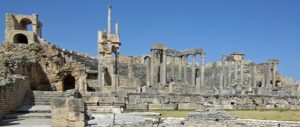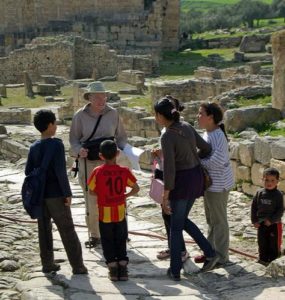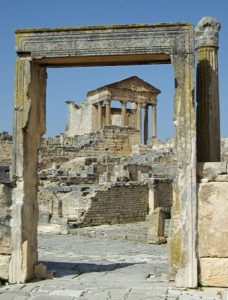Dougga which is a massive site and receives a lot of visitors.
The site is built on top of a hill and dominates the fertile valley below. It is a World Heritage Site and has been described as the best preserved small town in Northern Africa. It has had a long history of settlement from the 4thC BC when it was under the control of CArthage. By the 2ndC it was the regional economic and administration centre for the area. Families continued to live among the ruins until the 1950s when they were relocated. There is still a small farm in the north eastern part of the site near the Ain Mizeb cisterns.
The site is well cared for and there aren’t the number of wild flowers growing among the ruins as there are at Thuburbo Majus. To do justice to the site you need to allow 3-4 hours. We didn’t have a lot of time to visit the site so decided to concentrate on the theatre, cisterns and capitol areas.
There is a large car park beside he ticket office, toilets, small reception area with basic cafe and shop selling a selection of dog eared postcards and a few books.
We started off with the theatre which is the first building you see as you enter the site. It is a massive structure with a semi circle of 19 tiers of seats rising above the stage. These have been cut into the slope of the hill to increase stability. At the base of the seats is the semicircular orchestra with the stage above. The massive columns at the back of the stage survive. The theatre has been extensively restored and is used for performances during the summer months.
We lost the crowds as we followed the farm track up through the olives to the Aïn Mizeb cisterns near the farm. These were the main water supply for the town. The area was rather untidy as it was being used for general storage by the farm. Two cisterns were barricaded off. We then dropped down a path through olive trees underplanted with wheat to Arch of Severus Alexander and Aïn el Hamman cisterns which had lost their roof. This meant you could see the internal structure. There were separate compartments which restricted the loss of water if one part was damaged. It also meant cleaning and repairs could be carried out without loss of water supply.
Near by are the impressive ruins of the Temple of Juno Caelestis with columns and the remains of a semicircular row of columns behind. Apart from a group of Tunisian women and children picnicing we were the only tourists in this part of the site. The children were fascinated by the sight of foreign tourists and there was much calling of ‘bon soir, hello…’ They wanted to know our names and told us theirs. One girl wanted a picture taken with us.
The capitol is a splendid building on a raised platform reached by a steep flight of steps. The walls still stand 10m high and were built using large upright stones to provide strength and support with smaller stones between them; a style know as Opus Africanum. The columns support the portico with a much eroded carving of Antonius Pius being carried off by and eagle. columns and portico and with walls standing nearly to their full height.
There is little left of the forum as the stones were robbed for the construction of a 6thC Byzantine fort, but only traces of this are left. Place de la Rose des Vents is a large paved area which was built as an extension to the forum. Adjacent to it is the market area with the remains of stalls.
The rest of the town drops away from the forum and is a mass of remains of walls of houses with walls standing 3-4’ high and streets. At the bottom of the site is the Libyo-Punic Mausoleum, which is described as the country's finest pre-Roman monument. However it looked a long way below and a steep climb back up in the afternoon heat. We admired it through the binoculars…
We headed to what marked on some maps as the ‘unidentified temple’ and as Dar el Ecgab on others, with its tall narrow archway and columns.
Dougga is a most impressive site and fully deserves its World Heritage status. It does need plenty of time to explore. We had copies of the plan and details of the walking tour from Lonely Planet and found they gave enough information to explore the site by ourselves. Guides are available but after listening to one of them, they are probably not worth paying for.










